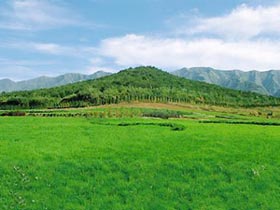
With Jackie Chan describing the Qinshihuang Mausoleum as a zero-gravity world in his latest blockbuster "The Myth," the 2,000-year-old underground palace remains a mystery for the world.
Despite curiosity about it across the world, most experts say "no" when asked about whether an excavation is feasible in the near future. The core region of the mausoleum, about 2.13 sq km wide, is well protected from any excavation, according to Chinese experts and officials. No excavation foreseeable.
"The current techniques mastered by the modern people cannot ensure the mausoleum can be protected well after excavation," said Duan Qingbo, head of the Qinshihuang Mausoleum Excavation Team under Shaanxi Provincial Institute of Cultural Heritage.
The State Administration of Cultural Heritage of China has consistently opposed any unnecessary excavation at the cultural heritage sites, especially at the large-scale emperor mausoleums like the Qinshihuang Mausoleum, unless some unexpected things occur like natural disasters, tomb robberies and vital infrastructure construction.
"All the objects in the tomb have been underground for thousands of years. They are used to the balance of the warmth and humidity underground and if we expose the relics to sunshine, oxygen or other gases, the balance will no longer exist and the relics will easily be ruined," said Zhang Bai, deputy director of the State Administration of Cultural Heritage.
"These changes are totally out of control," said Zhang. "We once dug out some ivory relics from a watery pit and they looked so shiny and white, but turned into dark powder within two hours after excavation."
"Excavation sometimes means destruction," said Michael Petzet, President of the International Council on Monuments and Sites (ICOMOS), "The underground Qinshihuang palace involves such a big region that we can not handle it after excavation."
Zhang and Michael Petzet, together with approximately 1,000 experts from about 85 countries, are attending the 15th ICOMOS General Assembly held at Xi'an, capital of northwest China's Shaanxi Province from October 17 to 21. This is the second ICOMOS General Assembly on heritage protection ever held in Asia, after the one in Sri Lanka in 1993.
"Excavation should not be carried out for fun, unless we are compelled to do so in building either important highways or high-rise buildings," he said. "We have some bad examples of excavations in Russia that soon lead to treasure hunting and tomb robberies."
"Let them sleep underground. It's safer," he said. Part of historical records true.
The latest research carried out by German and Chinese experts found a remarkable amount of coins inside the mausoleum, what could be described as the "central bank" of the underground palace, Petzet said Wednesday at the Assembly.
Using magnetic prospection, the finding might prove that the historical record that the mausoleum was filled with treasures are true.
The historical record say the first emperor spent about 38 years building his afterlife palace and enslaved about 720,000 laborers. He filled his mausoleum with mercury in the form of a lake and river layout in his country, and decorated the inside top of the mausoleum with the layout of the sun, the moon and other stars.
The simulated rivers and lakes could flow the way they do in the real world, and the sun, the moon, and the other stars could also revolve the way in the real world, and the emperor also filled the underground palace with numerous complicated weapons to ward off tomb robbers, according to Shi Ji, or historical records, compiled by famous Chinese historian Sima Qian, who lived in the dynasty after Qinshihuang's.
Experts have found the areas around the tomb contain a much higher density of mercury than other areas. The mausoleum also used a clever way to drain away groundwater from its center, a method still in use when building the foundation of modern constructions like the China Grand Theater, Duan acknowledged.
The latest prospection also found the round earthen man-made hill, about 50 m high and 350 m in diameter, contains symmetrical ladders and wooden construction. The coffin chamber is about 30 deep and tapers from 160 in length and 149 meters in width to 80 meters in length and 50 meters in width at the bottom.
The ancient Chinese hoped to create an afterworld in which they could live with objects they used in the real world, so many funeral objects would be buried along with the dead. These objects became a major harvest of today's archaeologists. Even today the practice of funeral objects still prevails in China's vast rural areas where people set fire to paper or tinfoil objects including TV sets, cars, money or other things in hope they could be used by the dead.
That's the general explanation why Qinshihuang built such a huge mausoleum for himself, said Duan, but there's something special about the emperor since all the kings before him and the emperors after him always wanted to be buried with treasures in the mausoleums they built when they were alive.
Archaeologists found the key 181 accompanying tombs, including the famous Terra-cotta warriors and horses pits, in an area of about 60 sq km, and a few have been excavated, Duan said.
"These accompanying tombs represented the official departments of his empire. These findings proved the emperor wanted to bring not only the country's geological layout, but also governmental arrangement into his tomb," Duan said.
The emperor moved into his underground palace at age 49 after ruling for 15 years and building the underground palace for about 38 years.
"He was lonely. He had been ambitious enough to unite China for the first time and arrange the country with a political system managed by the selected talents instead of his imperial blood kin," Duan said. "Though, it's well-known that he is described as ruthless and greedy."
(Xinhua News Agency October 21, 2005)
|

